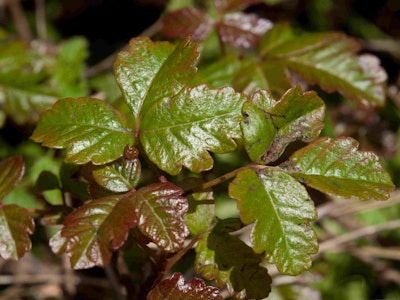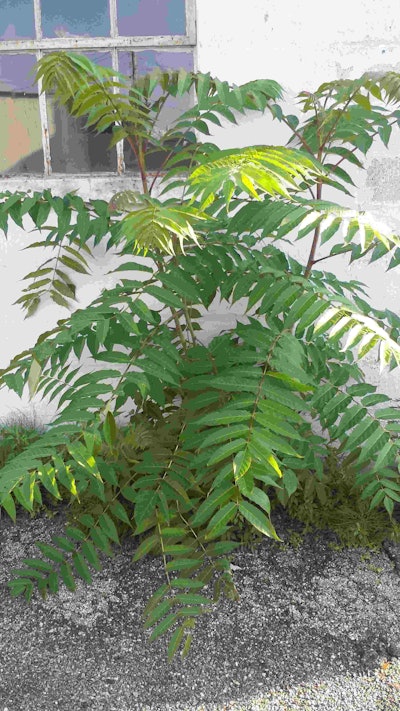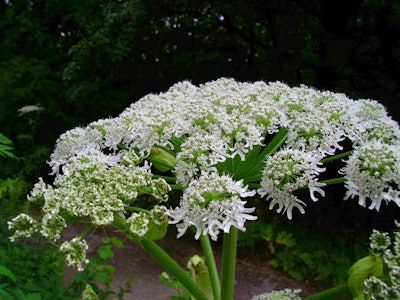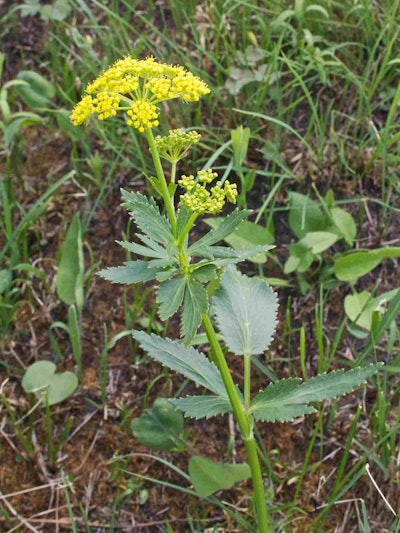 Poison ivy
Poison ivyPhoto: Wikipedia
Plants are not commonly thought of as a threat and a majority of the time, any that are poisonous must be ingested or eaten in copious quantities to inflict any damage.
However, there are some that can leave you burning, stinging, or itching after just making contact with one. Both your customers and your crews need to be on the lookout for these plants, so below are some common culprits, how to identify them, and remove them if they are abundant on your client’s property.
Poison ivy
The plant everyone is most familiar with for causing skin reactions is poison ivy, and it even has the saying “leaves of three, leave them be,” as the leaves always appear in groups of three leaflets, no more. However, this can be rather vague, as other harmless plants have a similar appearance, like Virginia creeper and boxelder.
The leaves of poison ivy always alternate on the stem and the end leaflet is always on a longer stalk than the laterals ones. Identifying poison ivy can be challenging because of the varying appearance it can have. The leaves can be glossy, hairy, or dull while the leaf edges can be smooth, toothed, or wavy.
Poison ivy prefers moist, wooded areas but can be found in ornamental plantings and various other areas. It will grow as a small shrub or a high-climbing vine.
All parts of the plant are poisonous, as it is covered in an oily resin called urushiol. This can cause painful rashes if it comes in contact with your skin, but it can also be transferred to clothing, tools, or pet’s fur, so people can have reactions later on if they touch something carrying the toxin.
When it comes to removing poison ivy, never burn the plant, as the smoke contains the oil and can irritate the lungs and possibly cause severe allergic reactions. Cultural controls include continual clipping or mowing the plant near the ground level. Ivy found in landscape beds can be dug out but take care to wear gloves and long sleeves to prevent skin contact.
If the plant’s spread is extensive, there are numerous herbicides that can help control the pest. Glyphosate or triclopyr can be used to help kill off poison ivy but should be used with the proper dosages and intervals.
 Pacific poison oak
Pacific poison oakPhoto: Wikipedia
Poison oak/poison sumac
Close cousins to poison ivy, are poison oak and poison sumac. Poison oak also tends to have three leaflets, but not necessarily all the time, so this rule of thumb is less dependable for this plant. It can grow as a shrub or a vine and has leaves that are similar to white oak leaves. Another distinguisher is the leaflets are covered in fine hair.
Meanwhile, poison sumac grows as a tall shrub or a small tree and has seven to 13 leaflets in a group and bright red stems. Poison sumac can be told apart from harmless sumac by noting that the berries are not perfectly round.
 Poison sumac
Poison sumacPhoto: Wikipedia
While poison sumac has the same urushiol oil, it has higher concentrations of the toxin making skin reactions more serious.
Controlling poison oak and poison sumac is similar to killing poison ivy. Poison oak can be manually removed, or it can be smothered with an impervious material. Poison sumac takes some persistent trimming over one or two years to starve it to death.
Herbicides are the main go-to for dealing with both poison oak and poison sumac. Cutting the stems back on either plant and applying herbicides such as glyphosate or triclopyr will ensure the plant takes it in immediately, but repeated applications may be necessary. Take care to remember that glyphosate is non-selective, and the effectiveness also depends on the timing.
Giant hogweed
Despite the alarming name, giant hogweed is an attractive plant that looks similar to Queen Anne’s Lace. This invasive plant is known to grow in New York, Pennsylvania, Ohio, Maryland, Oregon, Washington, Michigan, Vermont, New Hampshire and Maine. It was also just recently found in Virginia.
The plant grows between seven and 14 feet tall and has large umbrella-shaped flower clusters. It has large leaves and green stems covered in purple splotches.
The plant is dangerous thanks to its sap, which contains chemicals that cause the skin to be extremely sensitive to light, resulting in painful blisters. Contact with giant hogweed can result in long-term sunlight sensitivity and even blindness if the sap should get in a person’s eye.
 Giant hogweed
Giant hogweedPhoto: Wikipedia
While it may be tempting to consider chopping down the plant and being done with it, the New York State Department of Health advises against this, as it will only put up new growth and put you at risk of being exposed to the sap.
Root cutting and flower head removal are some of the manual control options which prevent the plant from spreading further. Like the other problem plants, glyphosate is considered an effective option for killing off giant hogweed.
However, it is important to monitor the site after the plant is gone, as hogweed seeds can remain viable in the soil for 15 years. This is why it is crucial to revegetate the area with other plants to prevent soil erosion and provide competition for giant hogweed seedlings.
Wild parsnip
Another plant that causes “phytophotodermatitis” or sensitivity to the sun after being exposed to the sap, wild parsnip is similar to giant hogweed.
 Wild parsnip
Wild parsnipPhoto: Wikipedia
It can be identified by its symmetrical leaves with saw-toothed edges and tiny yellow flowers that are clustered together. It grows up to 4 to 6 feet tall.
It tends to be found along roadsides, in pastures and prefers sunny conditions. It is considered invasive in certain areas and is listed as a noxious weed in several states.
Careful mowing at the right time can help clear these plants out. It is important to mow when the plants have produced flowers but not seeds (late June or early July in most regions) to prevent them from spreading further. The stems tend to be tough, so often a traditional lawn mower will not do the trick.
Chemical control tends to work for in the early spring or late fall.
Remember no matter what plant you’re dealing with, it’s important to ensure that your skin is protected with long pants, long sleeves, boots, and gloves.









